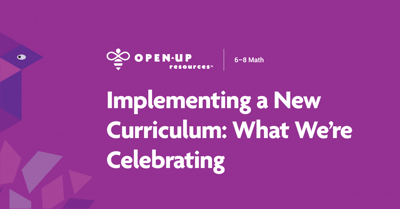 Change is hard.
Change is hard.
Those words may not ring more true than they do for a district leader going through a curriculum adoption. As a district curriculum leader in Guilford County Public Schools in Greensboro, North Carolina, I’ve led the implementation of a new math curriculum in 69 elementary schools and 23 middle schools. I’ve seen first hand how hard change can be, but I’ve also seen just how rewarding and beneficial it is for districts.
In this three part series I’m going to lay it all out for you—the good, the bad, and the lessons we learned firsthand during our curriculum adoption. We’re closing in on two years since we started the adoption process and have learned a tremendous amount along the way.
This is our first full school year with a district-wide math curriculum at all of our elementary and middle schools, and there are so many things we are celebrating!
We have equity regarding access to high-quality curriculum across our district.
For the first time, regardless of where you are districted to go to school, you have access to the same high-quality curriculum and materials. This was a huge win for us.
All students have the opportunity to receive grade-level work.
I cringed when I read The Opportunity Myth from TNTP and realized just how few students are engaged in appropriate grade-level work on a daily basis. Now that all students in Guilford County have access to grade-level curriculum in their classrooms, we know that they all have the opportunity to engage in appropriate tasks that address the standards daily. We believe this will be key to narrowing our achievement gaps.
Teachers are understanding the standards at a deeper level. In some cases, they are understanding standards for the first time.
Adopting a new curriculum really forces everyone in the district to take a deep look at the standards for the first time in a long time. Because we purposefully chose to adopt conceptually based curricula, our teachers have had to work to go beyond just understanding math at a procedural level – they’re understanding how it works, and why. This has allowed teachers to be more confident in the classroom and engage with concepts in a more coherent way.
Now that teachers have the “what” to teach, they can spend valuable planning time discussing the “how” to teach.
Without an adequate curriculum, so many of our teachers were spending their PLC time searching for activities, rich tasks, and assignments to keep kids engaged. Now that they have a curriculum that provides all of those things, they can spend time planning how to utilize the curriculum to improve student learning. Our PLCs are able to spend time analyzing student work, practicing instructional routines, and diving deep into the 5 Practices for Orchestrating Productive Mathematics Discussion rather than just resource gathering.
We are creating a common language from K–8 regarding models and diagrams we use.
Without a unified curriculum, our students were being exposed to an incoherent message regarding routines, models, and even vocabulary. What one school called a tape diagram, another may have called a bar model. This led to lots of student confusion when transitioning or transferring between schools. Now that we have a consistent curriculum, we have been able to norm around models and terms to provide a consistent message in our classrooms. This is especially key to struggling students, those who are English Language Learners, and Students with Disabilities.
We are nixing the tricks! (Well…we’re trying to.)
Shameful secret here, but we were guilty of teaching tricks and mnemonics to try to make math easier for our struggling learners. The problem is that in the long term these tricks leave students more confused and less confident in the classroom. By having a cyclical and coherent unified curriculum, we have been able to eliminate many of these tricks and trade them in for foundational skills and knowledge that will transcend all grade levels. Things like keep, flip, change, cross multiplying, and FOIL are finally disappearing from our classrooms.
Parents have resources to help their children at home with sample problems from every unit in every K–8 grade.
At the district level, we have always struggled with providing adequate home supports for families. Now that every school is using the same curricula, it is so much easier to provide sample problems and materials for students and parents to use at home. Families are able to access support materials online for all of our K-8 math curricula, and teachers have examples to send home with students.
Of course, not every part of implementing a new curriculum has been easy. (In fact, in my next blog I’m going to take an honest look at the challenges of the adoption process.) But I was so excited about all of these wins we had to celebrate.
And this isn’t even everything we’re celebrating in Guilford County! We know there will be more good things to come as our students and teachers get accustomed to the materials. For the moment, I’m excited to see us strive towards positive outcomes for all students in our district – and make them happen.

